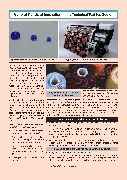General Trends of Innovation in the Technical Textiles Sector Hydrophobic cotton fabric (Source: LEITAT) ing will keep its important and tradi- tional role, although this will be slight- ly affected by innovation due to envi- ronmental aspects. There is a trend of generalization of coating and laminat- ing systems reaching maturity and awaiting the impact of developments in electro-spinning; the use of biotech- nology with finishing based on the ap- plication of enzymes; the solution to the current problem of adding micro- capsules or the consolidation of nano finishing. On the other hand, the still growing technologies of surface finishing through plasma technology or digital printing can quickly reach a stadium of maturity without becoming real sub- stitutes to the current technologies but rather occupying a complementary role due to technological and economic rea- sons. Other considerations regarding the last trends in the finishing sector: •Ecological consideration in finish- ing products (e.g. fluorine free). •Novelties in water-repellent finish- es but not in oil-repellents (there is no alternative to fluorocarbons) • •Insect repellent, antimicrobial, etc. finishes. which increase the num- ber of washes that hold the proper- ty. Dyeing auxiliaries to reduce water and process timeDigital printer (Source: fibre2fashion.com) Key challenges for the textile technology industrying markets and targeted by the Euro- pean societal challenges of active age- ing and safety and security. Textile technology is an enabling tech- nology for numerous fields and can make important contributions to new solutions for effective and affordable health care, highly functional sports- wear and goods and smart personal protection. All these are rapidly grow-CONTEXT Cost Action proposers de- fined the technological challenges de- scribed in this chapter for textile ma- terials in the healthcare and medical, automotive and aeronautic, sports, per- sonal protection and building and liv- ing sectors. Key challenges in the healthcare and medical sector: •development of controlled drug release fiber and textile structures for thera- peutics of different skin conditions •development of garments and home textile products with fully integrated bio- monitoring, active systems to improve life quality and ICT systems enabling remote monitoring of patients and assisted living services for “bet- ter ageing concepts” •development of fiber and textile structures with enhanced thermal/breathability electro-active properties with integration of new surface functionalities for improving barrier (antiviral and antibacterial) properties Key challenges in the automotive and aeronautics sector •integration of fully integrated and printed electro active and interactive sen- sors and actuators that enable the development of ubiquitous sensing and interactive surfaces, while also integrating fully embedded (or printed and/or fiber and yarn integrated) haptic feedback systems via both lighting integra- NCM-OCTOBER 2021 51
